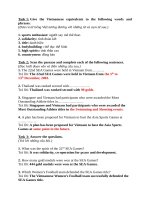reading unit 13 lop 10
Bạn đang xem bản rút gọn của tài liệu. Xem và tải ngay bản đầy đủ của tài liệu tại đây (5.11 MB, 18 trang )
Harry Potter is a series of seven fantasy
• ……………
novels written by British author, J. K.
Animation
Rowling.
• …………… is the type of Tom and Jerry
movie.
2020
• "Kí sinh trùng,” is a Korean film, won
the
awards
for
best
picture,
director,
Musical, romantic,and fantasy
foreign language film, and original
screenplay at the ……………. Oscars.
•Unit 13 FILMS AND CINEMA
•Reading skill
•Teacher: Nguyen Thi Kim Ngan
vocabulary
• motion(n) the act of moving:
chuyển
động
motion to and from: chuyển động qua
lại
motion(v): ra hiệu
still(adj)
=silent(synonym):
làm thinh, phẳng lặng
still(n) sự yên lặng, sự tĩnh mịch
-> still picture: bức tranh tĩnh
vật.
audience(n)
=viewer
Khán giả
spread (n) sự phổ biến, sự lan rộng, sự
lan ra.
Definition: the development or growth
of something so that it covers a larger
area or affects a larger number of
people
Example: The spread of the COVID 19
pandemic has been alarming.
replace(v)
thay thế, thay chỗ của ai/cái gì
Scanning
•Scanning is reading a text quickly in
order to find specific information, e.g.
figures or names.
cinema
sequence
decade
rapidly
scene
character
Activity 1: Find the word and matchTask 1 in the textbook
page 133.
• 1. cinema: rạp chiếu phim
• 2. sequence: cảnh (trong phim), sự liên tiếp
• 3. decade: thập kỉ
• 4. rapidly: nhanh chóng
• 5. scene: màn (của phim)
• 6. character: nhân vật
Activity 2: ANSWER THE QUESTION
• 1. When did the history of cinema begin?
• 2. What did scientists discover at the time?
• 3. Did films in the early days have sound?
• 4. When were audiences able to see long films?
• 5. When was sound introduced?
• 6. What form of films appeared as the old silent films were
being replaced by spoken ones? (Loại hình điện ảnh nào đã
xuất hiện khi các phim câm được thay thế bằng phim có tiếng
nói?)
• 1. The history of cinema began in the early
19th century. L1,2
• 2.At that time, scientists discovered that
when a sequence of still pictures were set
in motion, they could give the feeling of
movement. L2,3
• 3.No, they didn’t. L5,6
• 4.Audiences were able to see long films in
the early 1910s.L8,9
• 5. The sound was introduced at the end of
the 1920s. L13
• 6.As the old silent films were being
Activity 3:
TRUE OR FALSE
Read the passage, decide whether the sentences
are True or False.
Films
A film, also called a movie or motion picture, is a series of still images on a strip of plastic which,
when run through a projector and shown on a screen, creates the illusion of moving images. A film
is created by photographing actual scenes with a motion picture camera; by photographing
drawings or miniature models using traditional animation techniques; by means of CGI (Computergenerated imagery) and computer animation; or by a combination of some or all of these
techniques and other visual effects. The process of filmmaking is both an art and an industry.
Films usually include an optical soundtrack, which is a graphic recording of the spoken words,
music, and other sounds that are to accompany the images. It runs along a portion of the film
exclusively reserved for it and is not projected.
The name "film" originates from the fact that photographic film (also called film stock) has
historically been the medium for recording and displaying motion pictures. Many other terms exist
for an individual motion picture, including picture, picture show, moving picture, photoplay, and
flick. The most common term in the United States is a movie, while in Europe film is preferred.
Terms for the field, in general, include the big screen, the silver screen, the movies, and cinema;
the latter is commonly used in scholarly texts and critical essays, especially by European writers. In
the early years, the word sheet was sometimes used instead of the screen.
• 1.Computer Generated Imagery is one of the techniques used to create films.
• a. True
• b. False
• 2.The process of filmmaking is just for art.
• a. True
The process of filmmaking is both an art and an
• b. False
industry.
• 3.Soundtracks are projected with the film.
• a. True
Films usually include an optical soundtrack………the film exclusively
reserved for it and is not projected.
• b. False
• 4.The origin of the term film originates from the art of photography.
• a. True
The name "film" originates from the fact that photographic
• b. False
film (also called film stock)
List the advantages and disadvantages of watching movie.
Advantages
Disadvantage









